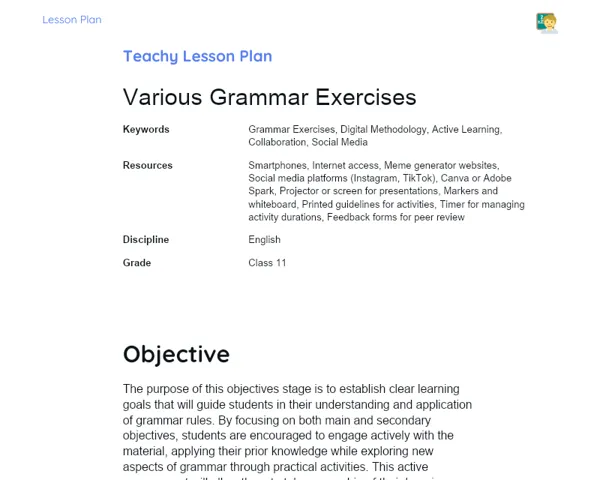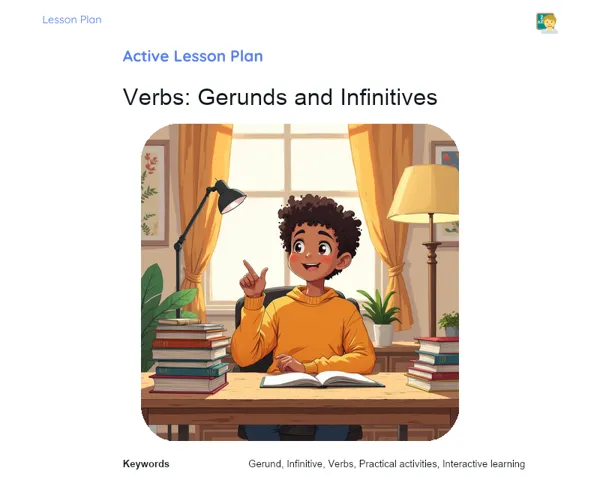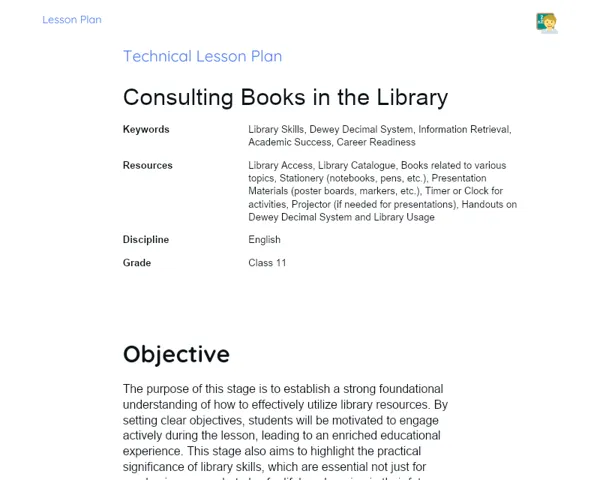Lesson Plan | Lesson Plan Tradisional | Vocabulary: Human Body Parts
| Keywords | Vocabulary, Parts of the Human Body, English, 9th Grade, Expository Methodology, Recognition, Naming, Understanding, Practical Examples, Discussion, Engagement, Review, Knowledge Consolidation |
| Resources | Whiteboard and markers, Projector and computer for presentation slides, Slides with images of the human body's parts, Activity sheets with vocabulary exercises, English dictionaries, Notebooks and pens for student notes |
Objectives
Duration: (10 - 15 minutes)
The aim of this stage is to equip students with the specific vocabulary related to the parts of the human body in English. By establishing clear objectives, students will know what is expected of them during the class, making it easier to grasp and apply the content presented.
Objectives Utama:
1. Recognize and name the main parts of the human body in English.
2. Understand the meaning of terms related to the human body's parts in English.
3. Enhance specific English vocabulary related to the human body.
Introduction
Duration: (10 - 15 minutes)
The aim of this stage is to prepare students to understand the specific vocabulary linked to human body parts in English. Setting clear objectives will provide students with an overview of what they need to learn, aiding in retention and application of the content covered.
Did you know?
Did you know that many medical terms in English have roots in Latin and Greek? For example, the term 'cardiology' originates from the Greek word 'kardia', meaning heart. Additionally, being familiar with the vocabulary for the human body's parts can enhance the understanding of how our body functions, promoting greater awareness about health and well-being.
Contextualization
To kick off the lesson on human body parts in English, initiate with relatable scenarios from the students' daily lives. For instance, articulate that knowing the vocabulary for human body parts is crucial in various real-life situations, like visiting doctors, attending physical education classes, or even while watching films and series in English. Highlight that by grasping and correctly using these terms, students can communicate effectively in various contexts.
Concepts
Duration: (30 - 40 minutes)
This stage aims to provide a detailed understanding of the main parts of the human body in English, allowing students to become familiar with the relevant vocabulary. By exploring each body part and its functions, students will be able to connect the learned vocabulary to everyday situations, aiding retention and practical application.
Relevant Topics
1. Head: Discuss that the head includes significant parts like 'skull', 'face', 'eyes', 'nose', 'mouth', 'ears', and 'hair'. Describe each part's function and its role in daily activities.
2. Torso: Explain the main components of the torso, such as 'neck', 'shoulders', 'chest', 'back', 'abdomen', and 'waist'. Illustrate their importance in supporting the body and protecting internal organs.
3. Upper Limbs: Enumerate the parts of the arms and hands, like 'arms', 'elbows', 'wrists', 'hands', and 'fingers'. Elaborate on their use in performing daily tasks and the significance of motor coordination.
4. Lower Limbs: Explore the segments of the legs and feet, including 'legs', 'knees', 'ankles', 'feet', and 'toes'. Explain how these parts bear body weight and facilitate movement.
To Reinforce Learning
1. Name three parts of the body found in the head and mention their functions.
2. Explain why the torso is crucial for safeguarding internal organs.
3. Describe the role of the upper limbs in daily activities.
Feedback
Duration: (25 - 30 minutes)
The aim of this stage is to review and reinforce the knowledge students have gained about human body parts in English. Through discussion and engaging reflective questions, students will have the chance to apply the vocabulary learned in practical contexts, enhancing their understanding and ensuring better retention of content.
Diskusi Concepts
1. Discussion of Questions: 2. 1. Name three parts of the body found in the head and mention their functions. 3. - Eyes: Facilitate vision, allowing one to see the surroundings. 4. - Nose: Essential for breathing and the sense of smell. 5. - Mouth: Used for eating and communicating through speech. 6. 7. 2. Explain why the torso is crucial for safeguarding internal organs. 8. - The torso, comprising the chest and abdomen, houses and protects vital organs such as the heart, lungs, liver, and intestines. It also provides structural support to the body and connects the upper and lower limbs. 9. 10. 3. Describe the role of the upper limbs in daily activities. 11. - The upper limbs, made up of arms, elbows, wrists, hands, and fingers, are vital for executing daily tasks like writing, picking up items, cooking, and engaging in activities that require fine and coarse motor skills.
Engaging Students
1. Questions and Reflections for Student Engagement: 2. 1. Which part of the body do you think is the most important and why? 3. 2. How can knowing the human body's parts be helpful in an emergency? 4. 3. Can you think of a daily activity where you use multiple body parts at once? Describe it and mention the body parts involved. 5. 4. How can understanding the body parts vocabulary in English help when traveling abroad? 6. 5. What distinguishes the functions of the upper and lower limbs in sports?
Conclusion
Duration: (10 - 15 minutes)
The purpose of this stage is to recap and consolidate the content discussed during the lesson, ensuring students possess a cohesive understanding of the vocabulary learned. By summarizing key points and discussing the practical importance of the knowledge gained, students will be better equipped to retain and effectively use the vocabulary.
Summary
['Head: skull, face, eyes, nose, mouth, ears, hair.', 'Torso: neck, shoulders, chest, back, abdomen, waist.', 'Upper Limbs: arms, elbows, wrists, hands, fingers.', 'Lower Limbs: legs, knees, ankles, feet, toes.']
Connection
The lesson bridged theory with practice by detailing each part of the human body in English, explaining their functions and significance in daily activities. The examples and practical questions supported students in visualizing how vocabulary applies in real-life situations, such as medical check-ups and physical activities.
Theme Relevance
Knowing the parts of the human body in English holds great relevance in daily life, particularly in international contexts and medical emergencies. Familiarity with these terms can ease communication during travels, medical consultations, and even while engaging with English media, fostering a greater understanding and effective responses in practical scenarios.



